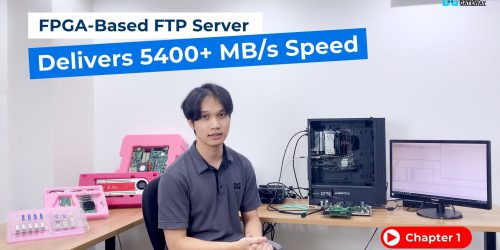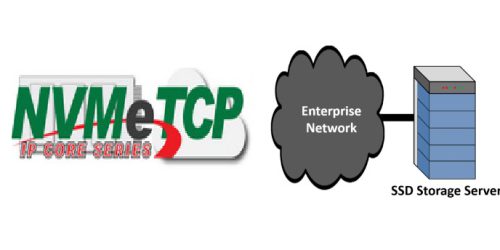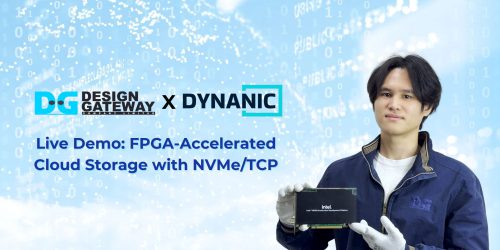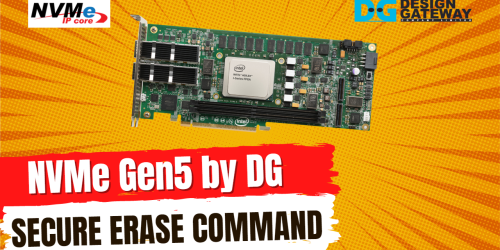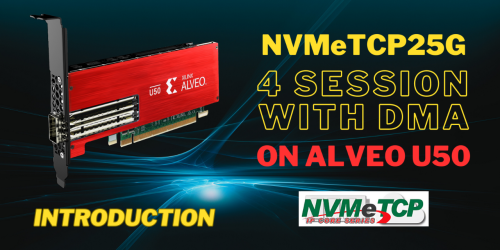Experience the Power of 20GB/s SSD Performance with 2CH NMVe-IP Gen5 RAID0 Demo
Join us for an exciting demo featuring the Intel Agilex 7 I-series board and the Design Gateway NVMe-IP. Witness the power of two NVMe-IPs and SSDs operating in RAID0, achieving an outstanding 20 Gbytes/sec write transfer speed.
In this article, we explore the architecture and provide a real-board demo of this cutting-edge system. Discover the enhanced performance and dive into the world of advanced storage technology. We’ll guide you through the hardware setup and demonstrate how the two-channel RAID0 configuration delivers a staggering 20,000 Mbytes/sec write speed.

Welcome to our demo featuring the Intel Agilex 7 I-series board and the Design Gateway NVMe-IP.
The outstanding 20 Gbytes/sec write transfer speed is achieved through the power of two NVMe-IPs and SSDs operating in RAID0.
We will explore the architecture and a real-board demo of this system. Get ready to unveil the enhanced performance and discover a new level of storage technology.

Before we proceed, let’s recap the impressive write transfer achieved with our NVMe-IP for Gen5.
Each NVMe-IP offers direct access to an NVMe SSD. Our dedicated test logic sends write command requests and data to the NVMe-IP at maximum speed.
The console displays the measured write speed as the test result.

Our demo showcases a write speed exceeding 10,000 Mbytes/sec.
Now, let’s dive into how the 2-channel RAID0 enhances write performance.

Introducing our two-channel RAID0 system, it incorporates an additional NVMe-IP for integration with another NVMe SSD.
The RAID0 controller is used for switching the test data on Test logic to transfer between the two NVMe SSDs. Operating two SSDs in parallel, it achieves a doubling of write performance. Our RAID0 configuration reaches an impressive 20,000 Mbytes/sec.

To operate the two-channel RAID0 demo utilizing the NVMe-IP for Gen5, three components are required:
- Agilex I-series board
- AB19-M2PCI adaptor board
- Two NVMe Gen5 SSDs
2-ch RAID0 Demo Setup

To set up the RAID0 demo, follow these steps for hardware configuration.
- Firstly, connect the two NVMe SSDs to AB19 the adapter board.
- Connect one SSD to CN1 and the other to CN2.
- Secondly, connect the PCIe power to the AB19 adapter board.

- Afterward, attach the adapter board to the PCIe connector on Agilex-I board.
- Adjust the height of the AB19’s supported board, and tighten the wing nut to ensure a stable setup.
Now the SSD connections are completely set up. Let’s continue to setup the Agilex-I board.
- Connect the micro USB cable from the Agilex-I board to your PC.
- Next, connect the power adapter to the board, and then switch on the power of the Agilex-I board.
- Finally, download the demo configuration file to the board, and open the terminal to select the test option.
Demo : Write speed

In our RAID0 demo, we utilize two NVMe Gen5 SSDs, namely Gigabyte Aorus 10000 and CFD Gaming.
Let’s focus on the write performance while configuring a transfer size of 256 Gbytes and utilizing the LFSR data pattern.

The report reveals an outstanding write speed of 20,000 Mbytes/s.
However, it is important to note that these SSDs offer peak performance for a limited duration.
Specifically, both the Aorus and the CFD Gaming Gen5 SSDs can sustain their peak performance for approximately 30 seconds.

The compact size of the NVMe SSD integrating with the power of FPGA enables next-level performance for portable devices. With a write speed of 20,000 Mbytes/sec, these devices support recording 8K resolution video at up to 165 frames per second.

The RAID0 feature presents an advantage in enhancing transfer performance by increasing the number of channels. By utilizing four channels, we can achieve a remarkable boost in write performance, elevating it to 40,000 Mbytes/sec.

Explore the details of our two-channel RAID0 demo using NVMe-IP Gen5 and download the free evaluation configuration file from our website to experience the power of this advanced storage solution.
Unleash next-level performance by visiting our website today. https://dgway.com/NVMe-IP_A_E.html
YouTube: https://youtu.be/hvSw5NVKaQk
Article about NVMe-IP Gen5

